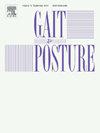有无骨质疏松的绝经后妇女的体位控制研究:静站立时压力变异性中心与负重不对称指数的关系
IF 2.2
3区 医学
Q3 NEUROSCIENCES
引用次数: 0
摘要
体位不稳定是跌倒的主要预测因素。本研究利用线性和非线性参数探讨了压力中心(CoP)变率。它研究了体重不对称(WBA)与姿势稳定性的关系,为绝经后骨质疏松妇女跌倒机制提供了见解。方法34例绝经后妇女,年龄57.10 ± 4.49,BMI 29.11 ± 4.76 Kg/m2,不运动,根据腰椎t评分分为两组:骨质疏松组(n = 17,t评分≤- 2.5)和非骨质疏松组(n = 17,t评分>;−1)。采用访谈法实施国际跌倒效能量表(FES_I)。通过数字式手持式测力仪测量下肢肌肉的等距强度,并记录CoP轨迹,提取线性和非线性参数。同时,使用动作捕捉系统跟踪受试者的支持基础(BoS)。结果两组患者年龄、BMI均无显著差异。与非骨质疏松组相比,骨质疏松组FES_I评分明显升高,髋关节外展肌力量降低,CoP摇摆速度和位移的标准差(SD)增加,额平面CoP熵降低。此外,骨质疏松的女性表现出明显的WBA,偏向于非优势侧,而非骨质疏松的女性表现出较不明显的WBA程度。结论:在安静站立时,减少的CoP熵和增加的额平面WBA可能代表了中枢神经系统旨在减少姿势控制不可预测性的策略。这些调整也可能为骨质疏松症妇女的动态任务提供必要的稳定性,值得进一步研究。本文章由计算机程序翻译,如有差异,请以英文原文为准。
Postural control investigation in postmenopausal women with and without osteoporosis: The relationship between the center of pressure variability and weight bearing asymmetry index in quiet standing
Introduction
Postural instability is a key predictor of falls. This study explored center of pressure (CoP) variability using linear and nonlinear parameters. It examined how Weight-Bearing Asymmetry (WBA) relates to postural stability, offering insights into fall mechanisms in postmenopausal osteoporotic women.
Methods
Thirty-four postmenopausal women, aged 57.10 ± 4.49, BMI 29.11 ± 4.76 Kg/m2, non-exercising, participated in the study and were divided into two groups based on their lumbar T-score: the osteoporotic (n = 17, T-score ≤ −2.5) and the non-osteoporotic (n = 17, T-score > −1). The fall efficacy scale International (FES_I) was administered through an interview. Isometric strength of the lower extremity muscles was measured through digital hand-held dynamometer, and CoP trajectories were recorded to extract linear and non-linear parameters. Simultaneously, the subjects' base of support (BoS) was tracked using a motion capture system.
Results
No significant differences were found in age and BMI between groups. The osteoporotic group demonstrated significantly higher FES_I scores, reduced hip abductor strength, increased standard deviation (SD) of CoP sway velocity and displacement, and decreased CoP entropy in the frontal plane compared to the non-osteoporotic group. Additionally, osteoporotic women exhibited a pronounced WBA, favoring the non-dominant side, whereas non-osteoporotic women showed a less marked degree of WBA.
Significance
It is concluded that the reduced CoP entropy and increased WBA in the frontal plane may represent central nervous system strategies aimed at minimizing unpredictability in postural control during quiet standing. These adjustments may also provide the necessary stability for dynamic tasks in osteoporotic women, warranting further investigation.
求助全文
通过发布文献求助,成功后即可免费获取论文全文。
去求助
来源期刊

Gait & posture
医学-神经科学
CiteScore
4.70
自引率
12.50%
发文量
616
审稿时长
6 months
期刊介绍:
Gait & Posture is a vehicle for the publication of up-to-date basic and clinical research on all aspects of locomotion and balance.
The topics covered include: Techniques for the measurement of gait and posture, and the standardization of results presentation; Studies of normal and pathological gait; Treatment of gait and postural abnormalities; Biomechanical and theoretical approaches to gait and posture; Mathematical models of joint and muscle mechanics; Neurological and musculoskeletal function in gait and posture; The evolution of upright posture and bipedal locomotion; Adaptations of carrying loads, walking on uneven surfaces, climbing stairs etc; spinal biomechanics only if they are directly related to gait and/or posture and are of general interest to our readers; The effect of aging and development on gait and posture; Psychological and cultural aspects of gait; Patient education.
 求助内容:
求助内容: 应助结果提醒方式:
应助结果提醒方式:


